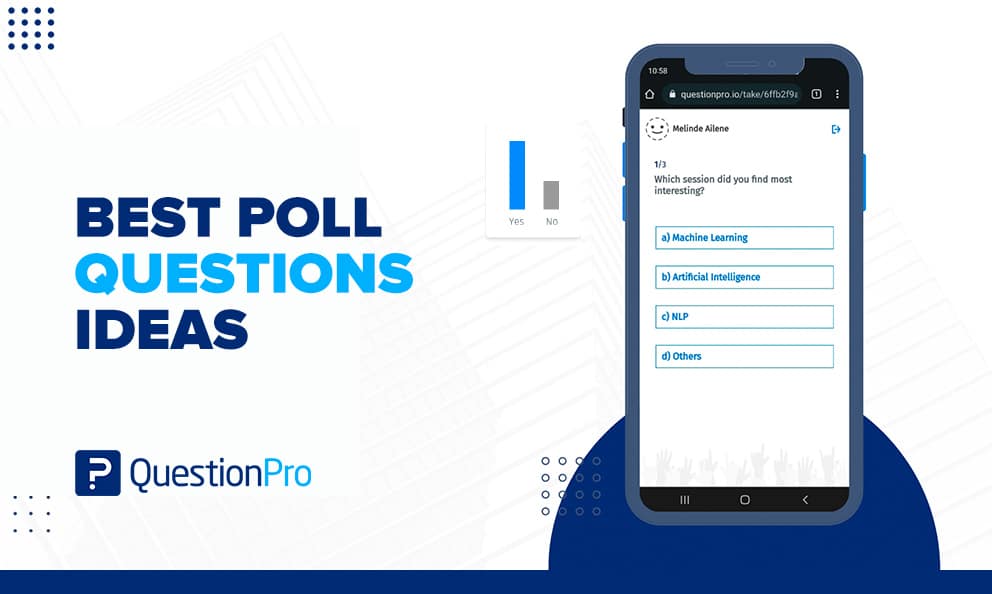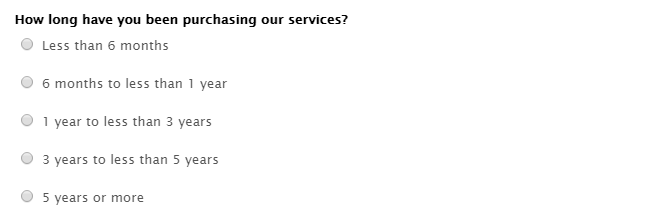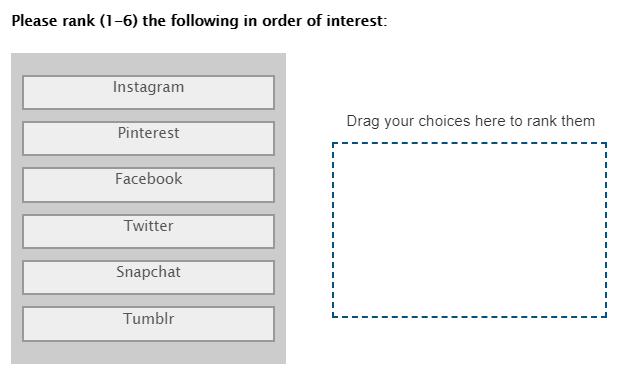 Reading Time: 7 minutes read
Reading Time: 7 minutes read
Popular poll questions with samples
Polls are quick and easy market research surveys that gauge feedback and opinions. Poll questions help to measure market sentiment in real-time. For instance, just before elections, live polls are used at regular intervals to gauge voters’ changing inclinations.
Generally, polls consist of a single closed-ended question typically limited to a maximum of 7 answer options to gather instant responses. The most fundamental step towards creating a great poll is the selection of the right questions.
The right questions and answer choices can help you gain valuable insights from your customers’ minds or followers. A good poll question encourages followers to answer the question honestly while also providing useful information about the people who answer your poll.
Polls have some fun trivia and hot takes that you can customize and randomize for a good time before team meetings, stand-ups, all-hands, or just for the heck of it. Here are ten common poll questions to help you design useful online polls and gather feedback.
Popular poll questions with samples
Multiple-choice poll questions have multiple-choice answer options. Most multiple-choice questions are limited to 5-6 choices. Respondents can select the best from the available options based on their preferences.
Make sure to consider your audience when creating your poll questions. The target audience can have a significant effect on the poll results.

2. Dichotomous Poll Question
Dichotomous is the most common type of all poll question to ask. It provides simple and straightforward answer options: Yes or No. These poll questions may also occasionally include a choice for “Maybe.” This question helps to understand your customers’ most essential opinions on your products or services.
You can also use this type of poll question to help filter respondents. For example, whether customers think the price is appropriate for a product. This type of poll is easy to answer and used in short and quick polls without any open-ended questions.

3. Net Promoter Score Poll Question
Understanding brand shareability is critical in determining customer satisfaction. The Net Promoter Score (NPS) question measures brand loyalty on a scale of 0-10.
This question identifies promoters, detractors, and passive customers by asking whether they’ll share their experience with your company with their family and friends.

4. Likert Scale Poll Question
Likert scale questions measure respondents’ degree of agreement or disagreement with the subject. This type of question is ideal for both market research as well as social science research.
It classifies into an Even Likert Scale, and Odd Likert Scale questions where even Likert scale questions do not feature a neutral response option and odd Likert scale questions offer a neutral response for respondents.

5. Semantic Differential Scale Poll Question
A semantic differential scale question asks respondents to rate a particular entity, such as a product, brand, or organization, on a scale with grammatically polar adjectives.
For instance, to measure the power of a product in the market in comparison to competitors, the semantic differential scale will have strong/weak as the polar adjectives. It’s an extremely reliable poll question type to collect precise respondent data.

6. Constant Sum Poll Question
Some poll questions have answer options that are more important to respondents than others. Depending on their preferences, the respondent can allot weight to each answer option. The Constant Sum question helps to understand the importance of different answer options.

7. Demographic Poll Question
Demographic online poll questions collect private information about a respondent, such as age, occupation, income, or ethnicity. The demographic question type provides information to help you divide your customer database based on background. Poll creators can use this segregated customer list to conduct better marketing activities cost-effectively.

8. Image Chooser Poll Question
Good poll questions work to enhance the user’s experience. Images are one easy way to spice up polls and catch your customers’ attention. Most people are more willing to answer survey questions with image answers instead of text responses. Using images helps you increase your response rates for opinion polls.

9. Rank Order Poll Question
Knowing customer priorities about various products or brands can provide an edge over the competition. Using rank-order poll questions, you can ask the respondents to rate the options based on a characteristic.

10. Visual Analog Scale (VAS) Poll Question
Originally used to monitor pain among patients in hospitals, visual analog scale questions have evolved. Today, VAS types are ideal poll questions for better understanding customer attitudes and traits on a continuous scale.

There are also some different types of poll questions you should learn:
Open-ended poll questions
Open-ended questions that allow responders to react on their own terms. For example, “What do you believe is our community’s greatest challenge?”.
Fun poll questions
Fun poll questions can engage respondents and create a fun, casual mood. Fun polls can be used at parties, events, social media, and online surveys to discuss personal preferences and pop company culture allusions.
Funny poll questions could ask participants about their favorite TV shows, movies, or music genres or to vote between amusing scenarios or hypothetical circumstances.
How to write great Poll Questions and avoid response bias?
Collecting accurate information can be challenging, but understanding your audience and writing great content will go a long way. Writing good poll questions is an art form. It requires getting the correct information from your respondents in a limited period. Here are some practical tips for creating a poll.
1. Be direct and ask multiple-choice questions
Multiple choice polls allow the respondent to see all the options, making their task easy. Be bold and make sure that you are communicating your purpose.
A good multiple-choice question should be mutually exclusive, avoiding ambiguity at all costs. A poor multiple choice question example is, “Describe your political affiliation? A – Democrat B – Republican.” This is a poor multiple-choice question because it assumes that the audience can only affiliate with one of two parties.
This limitation will affect your accuracy because it doesn’t account for people who identify with other parties or are not affiliated with the choices provided.
2. Speak your respondent’s language
Use simple, direct, and specific language in your questions. Start with basic questions and then make it more accurate. The best poll questions can be understood easily by the reader. And unless your polls are industry-specific, you should avoid jargon at all costs. Jargon can create confusion, which leads to response bias.
LEARN ABOUT: Self-Selection Bias & Selection Bias
3. No double-barrel questions
Including double-barrel items leads to more confusion rather than actionable insights. These occur when a question involves multiple subjects yet has only one answer.
For example, “Should the Government spend less on the military and more on healthcare?” The problem with the question is it’s impossible to see what the respondent is answering. Is the respondent opinionated about one subject and not the other?
Instead, ask two separate questions to get the most accurate answers. The best way to ask the above question: “Should the Government spend less on the Military?” Followed up by “Should the Government spend more on Healthcare?”.
4. Find the right sample size
Generally speaking, most national and state polls have a 500 – 1,000-person sample size.
This results in a margin of error of 3.2% – 5%. As the sample size decreases, the returns diminish. For example, the margin of error reduces significantly more with a study of 50 – 100 than with a survey of 500 – 1,000. Unless tenths of a percent matter to you, your survey sample does not need to be in the tens of thousands.
5. Find the right medium to ask your questions
Do you have a landline phone? Would you pick up when you get a call from an unknown or unlisted number? Do you live in a rural area?
These questions can lead to survey bias. For example, Republicans are more likely than Democrats to use a landline phone. With the accessibility of the Internet, web scraping or data mining should help pollsters get accurate analytics on national or statewide elections.
While getting a perfectly representative sample for election polls can almost be impossible, online surveys are often a great way to get the most accurate results across different demographics.
6. Remove all bias
Creating leading questions generally decreases the accuracy of your respondents’ answers.
In politics, loaded questions will suppress rational thought and result in knee-jerk reactions. For example, if you’re looking for opinions on the Affordable Care Act, calling it “Obamacare” can lead to a higher percentage of negative answers from those who oppose the law.
7. Best polls have a flow: Order questions accordingly
Ordering your poll questions is essential to give a sense of flow to the survey. Always rank your questions from simple concepts to complex ones.
If used properly, poll questions can help you make better decisions and improve customer and employee interactions.
We hope you’ll try one of the following poll ideas to make your online meetings and events more exciting in 2023!
Poll questions are an invaluable tool in your search for knowledge. By leveraging the right question types, taking wording and order into account, and considering the context of an audience, we can unlock a wealth of information. QuestionPro’s live poll feature lets you create polls and get instant feedback from your audience in real time.
No credit card is required!







